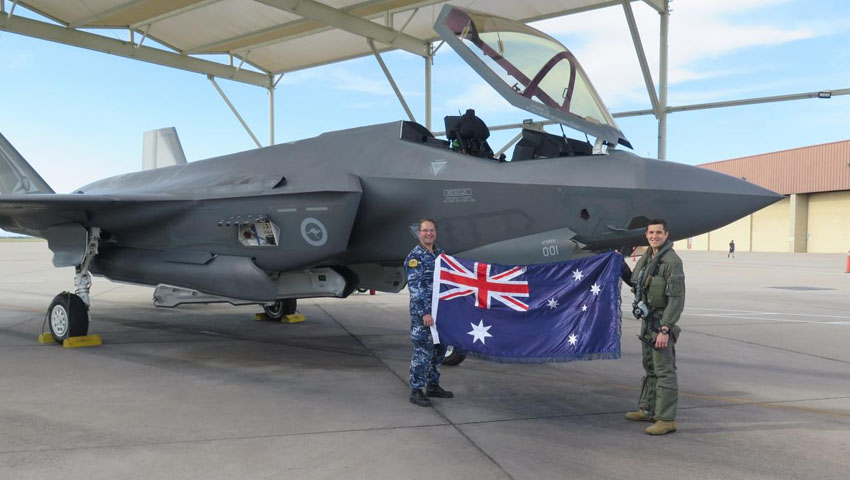While Royal Australian Air Force pilots and maintenance trainers based at Luke Air Force Base in Arizona wrapped up much of the training presence in 2019, the joint capability developed by the US Air Force and RAAF has meant Australia’s F-35 capability is now fully operational.
The Royal Australian Air Force has returned a majority of its F-35A Lightning II pilots, maintainers and aircraft to RAAF Base Williamtown, NSW, in December 2019, but still maintains a joint pilot-training and maintenance presence at Luke Air Force Base in Arizona.
Luke AFB plays a central role in fulfilling Secretary of Defense Mark Esper’s national defence priority of strengthening alliances and partnerships by training alongside the RAAF.
Major Christopher Baker, 61st Fighter Squadron instructor pilot and graduate of the F-35A pilot training program at Luke AFB, attests to the importance of the training partnership between the US Air Force and the RAAF.
He explained it is extremely rewarding to reinvest and train both nationalities in the same aircraft with the same tactics: "I feel like we contribute something to the US Air Force training mission by bringing our own unique perspectives, configuration, roles and environments to the mission, just like the US Air Force mission brings that to us as well. I think that's what's really useful about it being combined."
According to US Air Force Lieutenant Colonel Tom Hayes, 61st FS commander, three components enable the successful integration of the RAAF and the US Air Force: the platform, common tactics and the objective of training the world’s most capable fighter pilots.
"Other than the way the aircraft is painted, they're all exactly the same, so we have that common platform of flying the F-35. The common tactic is sharing the same training strategies between the RAAF and the US Air Force," Lt Col Hayes explained.
MAJ Baker said the COVID-19 delayed some of the RAAF student pilot training but the student pilots are determined to complete their requirements swiftly and efficiently.
"I am continually amazed at how the students learn so quickly. They come in the door knowing very little or nothing about the F-35 and four or five months later, they're flying high-end, large force-employment exercise missions with multiple aircraft involved in a dense surface-to-air missile threat scenario," MAJ Baker explained.
The chances of the RAAF and the US Air Force working together in a deployed environment is very likely according to MAJ Baker.
Lt Col Hayes added, "Most of the Australian pilots that have come through here at Luke (AFB) have worked with the US Air Force before in the Middle East. I don't think you'd meet many RAAF or US Air Force pilots that haven't interacted with each other before in some capacity, either operationally or in an exercise somewhere."
MAJ Baker explained that the RAAF established one operational and one training F-35A squadron at RAAF Base Williamtown and plans to establish another operational squadron in January 2021. As of October 2020, five RAAF F-35s are assigned to the 61st FS.
The first F-35 was delivered to RAAF Base Williamtown in 2018 and the 30th F-35 is scheduled to return to Australia by December 2020. Seventy-two F-35s are ordered and the last one is projected to be delivered to Australia by 2024.
MAJ Baker said the RAAF is aiming to declare initial operational capability – when a capability achieves its minimum threshold to support operations – by December 2020, ahead of the timeline. The RAAF’s first B-course for student pilot training is scheduled to launch in January 2021 and will be taught by instructor pilots who trained at Luke AFB.
In 2019, 34 fighter pilots were assigned to the 61st Fighter Squadron and 17 were RAAF pilots. As of October 2020, there are five RAAF instructor pilots, seven student pilots and two maintainers who continue to execute the joint training partnership mission.
Lt Col Hayes added that Luke AFB will continue to maintain an alliance with the RAAF in the future through exchange programs. The joint pilot-training at Luke AFB makes RAAF’s F-35 mission fully operational in Australia.
"To be able to keep those formal connections, we're heavily looking into exchange programs where we're actively trying to get one of our pilots to get an exchange assignment at RAAF Base Williamtown. They would serve over there for two or three years, just like we have exchange assignments with other partners. The Air Force Personnel Center is actively seeking applications to send," Lt Col Hayes added.
The Lockheed Martin F-35 Joint Strike Fighter is billed as a catalyst for the fifth-generation revolution, changing the face and capability of the RAAF and the wider Australian Defence Force.
For the RAAF, the F-35A's combination of full-spectrum low-observable stealth coatings and materials, advanced radar-dispersing shaping, network-centric sensor and communications suites – combined with a lethal strike capability – means the aircraft will be the ultimate force multiplying, air-combat platform.
The F-35A – the variant chosen by the RAAF – will have with a projected life of 30 years in service.
Over the coming years, Australia will purchase 72 of the advanced fifth-generation fighter aircraft as part of the $17 billion AIR 6000 Phase 2A/B program – which is aimed at replacing the ageing F/A-18A/B Classic Hornets that have been in service with the RAAF since 1985.








